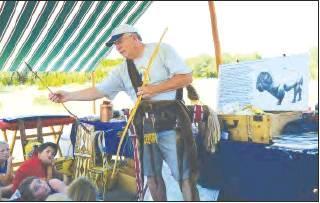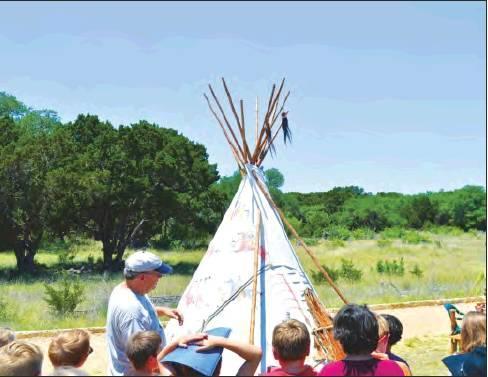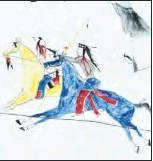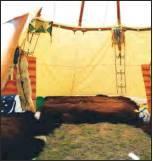Local man teaches Native American culture at elementary
HISTORY LESSON
How to do y ou explain to children who ar e used to shopping at HEB, that once upon a time people
depended on large herds of the American B ison, better known as the buffalo, for most their basic life necessities?
That instead of conv eniently opening a plastic
container, the North American Plains Indians instead hunted and r elied on these mighty beasts for everything from food, hides for shel - ter and clothes, thr ead, and even eating utensils?
Peter Durkin of Dripping Springs tackled that pr oblem when he v olunteered his time to teach elementary children about the indig - enous people of the G reat Plains. To set the stage he set up his two tipis, each tipi representing a different tribe. Each tipi’s made from stretched buffalo hides covering three or four wooden posts.
“An old Navajo woman said I was born in the wrong skin…as a kid I was always an Indian, not a cowboy,” Durkin said. Originally an easterner from Pittsburg, Durkin went to Texas A&M and got hooked on Native American culture.
“I got involved in pow-wows and met a lot of people. It fed my passion. Dances, powwows, desert museums, I’d buy books. I had to keep feeding it. I found it very interesting.” Durkin said. It has been his hobby for 35 years. “The more you learn, the more you realize how much you don’t know.
“When it came to tipis, the mother is the owner and is responsible for the setup. The men were the protectors. They were nomadic tribes and followed the seasons, with camp setup lasting a few days, until their animal out-grazed the grass. Then it was time to move on.
There was also etiquette when it came to tipis. If crossed sticks were at the entrance, it meant do not disturb. If the door was open, friends could enter. If the door was closed, a scratch on the door made of hide or a buffalo horn knocker would get the attention of the inhabitants.
When a man went into a tipi, he went to the right and waited for the host to invite him to sit at his left, in the rear of the inside. A woman would enter on the right. Mostly it would be men on the north side, women on the south.”
Hospitality was also a virtue of the tribes, when you visited, you would be offered drink and possibly soup, made of squash, corn, prairie turnips that were braided like garlic bulbs. A hot rock from the fire might be added to make it hot.
When horses arrived, it changed a lot. For example, dogs were the beast of burden and were soon replaced with horses that could carry large loads, but also men on horseback.
Their tipis became bigger too with horses. “It took 6 horses to move camp for one tipi,” Durkin said.
The buffalo and other hides were tanned with deer brains. A buffalo’s tendon separates and became thread for sewing, tipis, clothes and whatever was needed. Horns were used for cups, bones made the eating utensils.
The children were attentive in the heat and laughed about carrying a papoose in a frame you wear, and then hang in a tree, where “when the wind breaks the cradle will rock.”
Durkin’s truck has become custom in order to carry his tipis with roof racks that hold the tipis in place, while he crosses the U.S. for more pow-wows and conferences following his passion.






